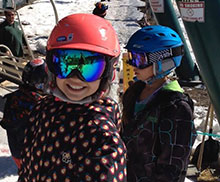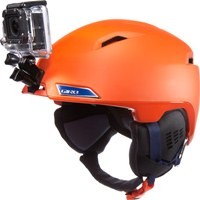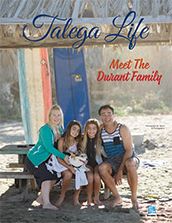
This article discusses how to find the best snowboard helmet for you.
Shop our selection of snowboard helmets.
Snowboard Helmet Basics
Just like running shoes differ from hiking boots, snow helmets are different from bike or skateboard helmets. They are made to handle the toughest obstacles you'll find on the mountain: trees, hard ice, gravity and the elements. They have specific features such as ear coverage, moisture-wicking liners and temperature-sensitive materials.
Components
The shell, or outer layer of the helmet, is a rigid surface (typically ABS high-impact plastic) that protects the head against sharp objects, knocks and abrasions. It also helps spread impact energy over a larger portion of the helmet during a fall.
The inner liner is typically made from EPS (expanded polystyrene) foam, the material that looks like Styrofoam®. It's designed to absorb impact and help reduce brain injuries.
In a hard fall, the liner foam can get compressed, a condition that you may or may not be able to discern. A helmet should always be destroyed and replaced after a serious fall.
Types of Construction
In-mold helmets are made by attaching the shell and shock-absorbing foam in a single molding process. They are sleek and much lighter than injection-molded helmets.
Injection-molded helmets use an EPS foam bonded to a separate shell, usually made of high-impact ABS plastic. These helmets offer more durability against everyday knocks and falls, while providing similar impact protection.
Some helmets have detachable ear pads and liners for adjustable warmth.
Get the Right Fit
If possible, try on helmets at SoCal Surf Shop or your local Shop to find one that is most comfortable. Your goals are to make sure it fits comfortably and sits on your head correctly for best protection.
Tip: Bring your goggles with you to the store and try them on with the helmet.
Find Your Size
You can do so by measuring your head or, if you are at SoCal Surf shop, just by trying on sizes. If using a tape measure, position it just above the ears and about 1" above your eyebrows. Measure around the largest part of your head (keeping the tape level) to determine the circumference of your head. Look at the chart on the helmet packaging to find your best size.
Check the Fit
A good helmet should feel snug but not tight. If the helmet can rock back and forth, the fit is too loose. Shake your head from side-to-side. If the helmet shifts, try a smaller size, adjust the sizing mechanism or use thicker sizing pads. Push up the front and back edges. If they move, tighten the straps.
There should be no gap between the top of your goggles and the helmet. Make sure the helmet fits snugly to the top of the goggles, but not so low that it hinders vision or pushes down the goggles.
The helmet should be positioned low enough in the front to protect your forehead. It should sit level with its front edge no more than 1" above the eyebrows. Finally, check to make sure there are no gaps between your head and the helmet lining.
Note: A few models use sizing pads to fine-tune the helmet's fit.
Chinstrap/Buckle
The chinstrap needs to fit back against the throat so it will not come off when it is impacted. The strap should fit snugly but loose enough for you to be able to chew food without feeling choked or pinched. Always fasten the strap before riding.
Helmet Features and Accessories
Vents
Vents bring cool air in and warm, sweaty air out. Some helmets have removable plugs, which means you need to take your helmet off to adjust the airflow. More desirable are helmets with adjustable vents. With the push of a lever you can instantly fine-tune your airflow level and not interrupt your ride.
Safety Certification
ASTM F2040 is the most common snow helmet certification. This U.S.-based standard covers nonmotorized recreational snow sports including skiing and snowboarding. All snow helmets sold at SoCal Surf Shop meet this certification. Look for the ASTM sticker on the inside of the helmet to ensure its certification.
CE EN1077 is a European certification for alpine skiing and snowboarding helmets. Some helmets are certified to both ASTM and CE EN standards, though one could conceivably meet the CE EN standard but not the ASTM standard. Currently, a few snow helmets sold at REI have both endorsements.
The Snell safety standard is rarely pursued these days by snow-helmet manufacturers and is no longer a factor in this category.
Important note: Helmets are valuable but not invincible. Per the ASTM website: "Although a helmet that meets this specification will help reduce the risk of some types of injuries to the head at slower speeds, the protection is limited."
Who Wears a Helmet?
Helmet usage by skiers and snowboarders at U.S. ski areas once again increased during the 2012/2013 ski season, according to a recent in-depth study completed by the National Ski Areas Association (NSAA). Overall, 70 percent all skiers and snowboarders wore helmets during the ski season, setting a new record for helmet usage in the industry. These new statistics reflect a 5 percent increase from the 2011/2012 season, when 67 percent of all skiers and riders wore helmets. “We have seen an amazing, collaborative effort to encourage helmet usage at ski areas,” said Michael Berry, NSAA president. “Ski areas, NSAA, medical organizations – even parents themselves – have all actively promoted helmet use. It’s pretty incredible when you think of how much we have achieved organically, without government mandates requiring helmets.” In 2011, New Jersey became the first – and only – state that requires those under the age of 18 to wear a helmet while skiing or snowboarding. And the percentage of minors wearing helmets also set a new record for the ski industry.According to the NSAA helmet study, 80 percent of skiers and snowboarders 17 and under wore helmets during the 2012/2013 season. In fact, nearly 90 percent of all children ages nine and under wore helmets, according to the NSAA study. The NSAA study breaks down helmet usage by nine different age groups . The age group least likely to
wear helmets is skiers and riders ages 18 to 24, with 60 percent wearing helmets last season, but nonetheless represents a 13 percent increase over the 2011/2012 ski season, when 53 percent of that age group wore helmets.
NSAA has conducted its industry helmet study annually for the past 11 years, and the growth in helmet usage in that span has been remarkable. The first year of the study in the 2002/2003 season – following the deaths of Michael Kennedy and Sonny Bono – NSAA found that25 percent of skiers and boarders wore helmets. Since then, helmet use has nearly tripled, with
usage rates increasing by 180 percent over this 11-year stretch. Similarly, helmet use among
minors has also seen sizeable gains over that span; during the 2002/2003 season, 32 percent of skiers and riders 17 and under wore helmets; this season, four out five skiers and riders in this age group (80 percent) were helmeted.




















